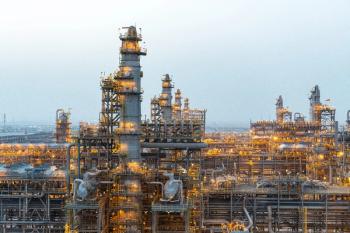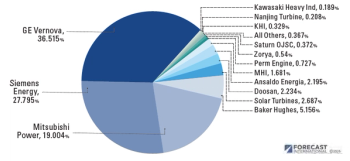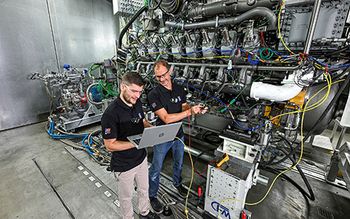
CMCs will revolutionize aero and land-based gas turbines
In the first article of his two-part series, the author discusses the advantages of CMCs, and how companies are beginning to see its benefits.
Ceramic Matrix Composites (CMCs)
are coming on strong for all gas turbines. This new material
will change the way the hot parts of gas are made, but before getting into CMCs let us start by telling
about a new light weight material called titanium aluminide (TiAl) that weighs 1/3 less than nickel
steel that is being used for the power turbines of the GEX and Leap aero engines where weight is most
important.
TiAl has been known for some time to be a very good material for this blading, but it was
difficult and even impossible to cast or machine to make such gas turbine parts. GE was persistent and
spent a lot of time and money finding a way to make parts by powdering TiAl and then through 3-D
printing, often times called additive manufacturing, to layer upon layer print and then fuse the powder
together. Parts could thus be made that could not be made any other way. Advanced new fuel nozzles
for GE's new fan jets are now being made this way by computer programs.
However, such a material for gas turbine blading is only a stepping stone for the next material to be
used for all gas turbine high temperature nozzle vanes and rotating blades beyond the GE-9X fan
engines. Here comes ceramic matrix composites (CMCs) to raise the CC efficiency from a 60 % level
to a whopping 65% according to GE to be a surprise of everybody. Yet the GE press releases over the
past year, when pieced together and studied, point to this direction. CMCs weighs just half that of
light weight Ti Al, is very durable and can withstand higher temperatures than single crystal blades and
vanes with very little or no cooling required. The GE developing engineer calls it “The Holy Grail”
for gas turbines. I say it will be a gas turbine revolution – far beyond just a breakthrough or game
changer.
Advantages and Rapid Progress of CMCs
The CMC blading being so much lighter in weight makes it possible for the gas turbine disks and
bearings to be reduced in size and weight. The fir tree connection of the blades to the disks can be
simplified and less costly to manufacture. The first of this year GE announced that it had been
successful in running an advanced military jet, the GE F 414, with second stage high pressure turbine
rotating blades made of CMC material. GE has also run an old J-47 non air cooled gas turbine with
first stage CMC nozzles and rotating blades and shows a video of the blades being installed.
By the
beginning of 2016 GE will probably give another press release of the progress being made with CMC
rotating high temperature blades. But the biggest advantage over the weight reduction for aero verses
the Heavy Duty (HD) gas turbines is the fact that little or no cooling air will be required for a either
machine thus leading to more gas turbine output and higher cycle efficiency for both.
Rolls Royce also sees the advantages of CMCs and last year bought out a California CMC
company called Hyper-Therm to get into the CMC business here in the US. R-R recently announced
the development of a large 100,000 pound thrust geared fan engine to have a 15 bypass ratio and a
cycle pressure ratio of 70. The planetary reduction gear now under test in Germany will have a
reduction ratio of about 4. The GT core could eventually use CMC turbine blades with such a high
compressor discharge temperature, too high to use for blade cooling, but initially R-R plans to cool the
CD air by means of the bypass air for blade cooling. R-R is not as far along with CMCs as GE.
The
arrangement
of the new geared R-R fan engine is pretty much a copy of the P & W new geared fan engine about
ready to enter service, but the much larger new R-R geared unit is several years away from
certification.
GE is bullish about CMCs, especially CEO Jeff Immelt, and has a pilot development plant in
operation in Newark, Deleware and a large all new plant ready to open in Ashville, North Carolina
devoted to making all sorts of stationary and rotating CMC parts for aero and land based gas turbines. G
E is now advancing both the aero and land based gas turbines in parallel and is incorporating
advancements in the latest X engines into the HDs without delay. The GE9x will have an overall
pressure level of 60 and will use CMC first stage nozzle vanes requiring very little cooling air. Later
versions are expected to use CMC first stage rotating blades as well. No doubt MHI and Siemens are
scrambling to keep up with GE who has taken the lead. The last of October GE announced the ground
breaking of two all new CMC plants, totaling over 200 million US dollars, in Alabama to make CMC
fibers and tapes for mass production of CMC parts for all gas turbines. Previously GE was and is still
getting the fibers and tapes from Japan.
In his next article, the author talks about the reheat gas turbine, and the advent of CMCs.
Ivan G. Rice was past chairman of the South Texas Section of ASME (1974 - 75), past chairman of the ASME Gas Turbine Division (now IGTI) (1975 - 76). A Life Fellow Member of ASME and Life Member of NSPE/TSPE, he has authored many articles and ASME papers on gas turbines, inter-cooling, reheat, HRSGs, steam cooling and steam injection.
Newsletter
Power your knowledge with the latest in turbine technology, engineering advances, and energy solutions—subscribe to Turbomachinery International today.





